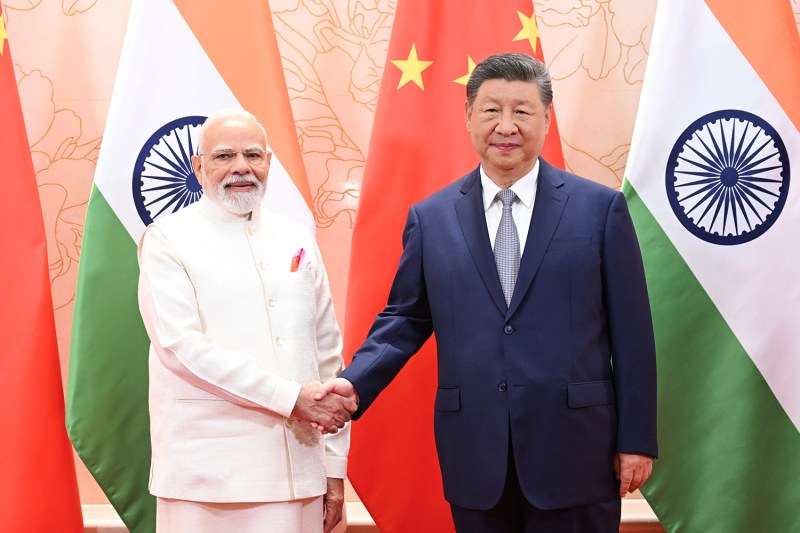Politics
Modi and Xi Seek Cooperation During Landmark China Meeting

Indian Prime Minister Narendra Modi made a significant visit to China over the weekend, marking his first trip to the country since 2018. The visit coincided with the Shanghai Cooperation Organisation (SCO) leaders’ summit, where Modi engaged in discussions with Chinese President Xi Jinping. The two leaders pledged to shift their dynamic from rivalry to partnership, with Modi emphasizing their commitment to cooperation.
This meeting comes in the context of a complicated history between the two nations. Just five years ago, relations soured dramatically following a deadly border clash in Ladakh, which sent tensions between India and China to their lowest point in decades. Observers speculate that recent strains in U.S.-India relations, particularly due to the imposition of high tariffs on Indian goods, may have motivated Modi to strengthen ties with Beijing. However, the reality is that this visit is the result of nearly a year of diplomatic efforts to ease tensions.
Efforts to Normalize Relations
Following the Ladakh incident, both countries initiated a military dialogue aimed at de-escalating border tensions. The thaw began to take shape last summer when border discussions intensified. Around the same time, India’s chief economic advisor highlighted the need for increased Chinese investment in India—a sector that had significantly declined post-conflict. In October 2024, both nations reached an agreement that allowed for the resumption of patrols along their disputed border.
By January 2025, India and China had agreed to work towards resuming direct flights between the two countries. Modi further announced in March 2025 that the border situation had stabilized and called for broader cooperation. While Modi’s visit signals a warming relationship, it is essential to note that tensions persist along much of their disputed border, which continues to fuel mistrust.
China’s alliance with Pakistan remains a significant concern for India, especially after recent conflicts that have seen Pakistan employing Chinese-made weapons. Fundamental disagreements also linger, particularly regarding the status of the Dalai Lama in India and growing Indian ties with Taiwan, coupled with China’s dam construction on shared rivers.
Despite these challenges, the geopolitical landscape is shifting. Both India and China agree on the importance of multipolarity and seek to counterbalance U.S. dominance in international affairs. Should India continue to face economic challenges due to U.S. tariffs, it may lean further into collaboration with China and Russia, potentially exploring new economic frameworks that bypass the U.S. dollar.
Regional Context and Ongoing Challenges
The implications of Modi’s visit extend beyond bilateral relations. In a tragic development, a 6.0 magnitude earthquake struck eastern Afghanistan, resulting in over 1,400 reported deaths as of Tuesday. The disaster highlights the humanitarian capacity constraints of the Taliban regime, which has seen a reduction in aid since they regained power in 2021. While international organizations like the United Nations and International Red Cross are mobilizing support, the need for assistance remains critical.
In Bangladesh, the election commission announced a timeline for national elections set for the first half of February 2025. This news comes as the public grows increasingly impatient with the interim government’s year-long tenure amid economic pressures and law enforcement challenges. Key stakeholders, including the military and interim leader Muhammad Yunus, are expected to support the timely conduct of elections to avoid potential unrest.
India’s economic performance also captured attention, with a reported GDP growth of 7.8 percent for the first quarter of the fiscal year, the highest rate in over a year. This growth has been attributed to a combination of factors, including preemptive exports to the United States before new tariffs took effect, increased domestic demand, and robust government spending. Yet, economic experts caution that ongoing U.S. tariffs could dampen growth later in the year.
As geopolitical dynamics evolve, Modi’s visit to China is a critical step in navigating the complex relationships in South Asia. While the meeting symbolizes a potential thaw in India-China relations, the underlying tensions and regional challenges remain, necessitating careful diplomacy moving forward.
-

 Business5 months ago
Business5 months agoKenvue Dismisses CEO Thibaut Mongon as Strategic Review Advances
-

 Lifestyle4 months ago
Lifestyle4 months agoHumanism Camp Engages 250 Youths in Summer Fest 2025
-

 Sports4 months ago
Sports4 months agoDe Minaur Triumphs at Washington Open After Thrilling Comeback
-

 Sports5 months ago
Sports5 months agoTupou and Daugunu Join First Nations Squad for Lions Clash
-

 Top Stories5 months ago
Top Stories5 months agoColombian Senator Miguel Uribe Shows Signs of Recovery After Attack
-

 World5 months ago
World5 months agoASEAN Gears Up for Historic Joint Meeting of Foreign and Economic Ministers
-

 Health4 months ago
Health4 months agoNew Study Challenges Assumptions About Aging and Inflammation
-

 Business5 months ago
Business5 months agoOil Prices Surge Following New EU Sanctions on Russia
-

 Entertainment4 months ago
Entertainment4 months agoDetaşe-Sabah Violin Ensemble Captivates at Gabala Music Festival
-

 Entertainment4 months ago
Entertainment4 months agoBaku Metro Extends Hours for Justin Timberlake Concert
-

 Top Stories5 months ago
Top Stories5 months agoRethinking Singapore’s F&B Regulations Amid Business Closures
-

 Business5 months ago
Business5 months agoU.S. House Approves Stablecoin Bill, Sends to Trump for Signature









